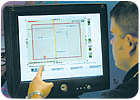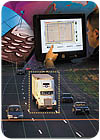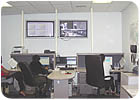Alarm monitoring sales generally keep pace with new sales of monitored systems. That means that in the current era of sluggish growth in alarm system sales, savvy central station alarm companies are looking for new opportunities outside their traditional monitoring business. Although some of these are niche opportunities, they are likely to grow in importance in coming years — and often provide significantly greater margins than alarm companies are accustomed to seeing on the monitoring side.
In this article, SDM profiles five alarm companies that have successfully branched out into new lines of business. This article also explores the economics and potential returns involved with these new offerings.

Environmental Monitoring
Security Associates, an Arlington Heights, Ill.-based central station, provides monitoring services on a wholesale basis and for its own accounts. Although the company does not install its own systems, it buys accounts from installing companies that prefer not to handle the ongoing monitoring.
One area where the company has been particularly successful is environmental monitoring. By including specialized sensors such as high- or low-temperature, carbon monoxide or water sensors as part of an initial system sale, the installing companies that sell their accounts to Security Associates are able to sign up customers for additional monthly monitoring fees of about $2.50 extra per sensor per month. Yet the additional cost to monitor those sensors is negligible. “One of the nice things from the central station and dealer perspective is that environmental monitoring doesn’t require a tremendous amount of investment,†notes Jim German, Security Associates senior vice president. What it does require, German says, is for the dealer’s salesperson “to understand and to present to the consumer the need for and benefit of the additional services.â€
Salespeople should notice environmental monitoring opportunities as part of the initial walk-through of a customer site, German advises. If, for example, a home has a laundry room on an upper floor, the homeowner is an excellent candidate for a water sensor. “As part of the security review, you should ask, ‘Do you have sump pumps?’†German adds. Owners of vacation homes, meanwhile, are excellent prospects for sensors that detect when the ambient temperature falls below or rises above a certain point.
In addition to the extra monitoring revenue, environmental sensors also can help reduce customer churn, German says. “The more benefits your alarm system provides, the greater likelihood that the customer won’t cancel service.†It’s all about being able “to sell an alarm system as more than just intrusion protection,†German says.
On the wholesale side, Security Associates does not charge extra for monitoring environmental sensors for its dealer customers, offering those customers an excellent opportunity to boost their own monitoring margins.

Vehicle and Asset Tracking
When policy makers required wireless phone service providers to be able to pinpoint the location of their customers, the goal was to enhance emergency response capability for 911 callers. But once carriers deployed that capability in their networks, it also opened some new revenue opportunities – for themselves and for central station monitoring companies. One central station that has begun to tap some of those opportunities is Acadian Mobile Monitoring, a business unit of Acadian Ambulance of Lafayette, La. Through a partnership with Guardian Mobile Monitoring Services Inc., Santa Monica, Calif., Acadian offers vehicle and asset tracking services that rely on the Cingular wireless network. “We handle everything from police departments to moms checking on their teenage children,†notes Blane Corneaux, Acadian vice president.
To support the service, Acadian installs a “beacon†provided by Guardian that includes a global positioning system (GPS) and a cellular transmitter inside the customer’s vehicle or attached to an asset that the customer wants to protect. For example, some local oil refiners use the service to protect their equipment.

The tie-in with the cellular network enables the system to keep track of where a transmitter is at any given time. Companies with mobile workforces typically get reports on where their vehicles travel during a day, while companies that are tracking stationery assets only use the tracking capability if an asset is moved out of its customary position.
Customers can use a browser interface to check in on their vehicles or assets as needed – and fleet-tracking customers also can get reports showing the location of each of their vehicles at specified intervals throughout the day. Fleet-tracking customers pay around $30 per month per vehicle for monitoring, while asset-tracking customers pay about $20 per month per transmitter. Monitoring revenue is shared between Guardian and Acadian – although the companies decline to reveal the exact split. They also decline to reveal what Acadian’s initial up-front investment was. A Guardian representative said that the amount would depend on the number of customers involved and other factors, but added that a central station could typically get started for less than $20,000.
After the initial transmitter installation, Acadian’s involvement with a customer is minimal – unless a vehicle’s driver activates a panic button, in which case central station operators will call the police or follow whatever instructions are provided by the customer. They can also send an e-mail link to the system to the police so that the police can see a vehicle’s location in real-time.
“It doesn’t take a whole lot of manpower from our end,†Corneaux notes. He adds, though, that as part of the monthly charge, Acadian also will configure customers’ Internet portals in response to customer requests. Although customers can handle such tasks on their own, some prefer the convenience of letting Acadian handle that responsibility.
Remote Access Control Management
Remote video monitoring systems aren’t the only systems that businesses sometimes prefer not to manage themselves. Affiliated Central Inc., New York, is a wholesale central station, which also monitors accounts for its own retail business known as DGA Security Systems. The central station has had success in managing access control systems for its own accounts and for dealers that use Affiliated for monitoring.
Affiliated president Stanley Oppenheim notes that there is substantial untapped demand for small access control systems controlling just two or three doors. But managing such a system can be a big challenge for a small business. “One employee might become knowledgeable about the system, but if he leaves, the institutional memory is lost – and if he goes on vacation, it’s a problem,†Oppenheim notes.
End-users that sign up for remotely managed access control services must have their own access control system on premises, and the system must be one that can be remotely administered via a dial-up or broadband link. When an authorized employee at the small business requests a change to the access control system, Affiliated personnel make the change using remote control software. “The users communicate the changes and we have established methodologies,†Oppenheim explains. “They don’t have to get involved in learning the software unique to the access control system. They e-mail or fax us the information and within an hour, it’s done.â€
The fact that the central station is manned 24 hours a day, seven days a week is a big selling feature of the service, Oppenheim adds. End-users appreciate the ability to make a phone call to enable someone to be let in after business hours – eliminating the need for the business manager to travel to the site and handle that task.
To support this offering, Affiliated had to invest in some remote viewing software, although some access control systems can be accessed via a Web browser, eliminating the need for that investment. There was also some expense involved in training central station personnel. Oppenheim declines to reveal what he charges for the service, but he is clearly bullish about it. “To properly penetrate the market for small access control systems will only be accomplished through central station-based and managed access,†he says.

Video Alarm Verification
As more municipalities across the United States report that police will not to respond to an alarm signal unless an intrusion has been verified, a new opportunity that has arisen for central station alarm monitoring companies is video alarm verification. One municipality that has enacted such a policy is Las Vegas, although police there still will respond to all panic alarms.
In response to the local ordinance, Las Vegas-based central station alarm company A-1 Security Ltd. has been offering video verification to its customers at a charge of about $100 per month, which also may include conventional alarm monitoring. When an account subscribing to the video verification service experiences an alarm, a video image of the site is automatically sent to the central station, along with the alarm signal. By viewing the associated video signal, central station operators can confirm whether an intruder is present and, if appropriate, dispatch the police, advising them that the intrusion has been verified. “All of our operators have knowledge of the system and can handle an alarm,†notes Bud Wulforst, president of A-1, adding that operators often can help police by providing descriptions of the perpetrators. Police also tend to respond more promptly when they know an intrusion has been verified, he says.

To support the offering, A-1 invested in two large plasma screens that can be viewed easily by multiple central station operators. The company also upgraded several existing computer monitor screens to help ensure video picture quality for individual operators and invested in central station automation software from Micro Key and Oz Station. The software upgrades, which cost about $10,000 to $12,000, enable the video signal coming in from a customer to be delivered to the central station operator who is handling the associated alarm signal.
Surprisingly, customers do not need to have a broadband connection to use the service. A-1 installs digital video recorders from Honeywell that offer good picture quality over a conventional phone line, Wulforst says. He adds, though, that the frame rate supported is a bit less than full-rate and there is a slight delay. The Honeywell DVRs are closely integrated with the control panels that A-1 uses, which are also from Honeywell. Because A-1 is not a wholesale central station and can control the type of equipment installed, it does not have to support a wide range of DVR and alarm panel combinations, which helped minimize the software investment required.
Wulforst notes that the video verification service has been most successful with small retailers and other accounts that already had video systems. “The thing most people don’t realize is that video verification is really only valuable to someone that already has an alarm system and video in place,†he says. “To try to sell outside of those parameters is difficult.†Spending $100 a month on video verification for faster police response is acceptable, he notes. But customers that don’t already have video balk at the capital outlay required, he says, often preferring instead to hire private guard services, which charge around $50 per incident to respond.
Corporate Retail monitoring
Wholesale central station Nationwide Digital Monitoring, Staten Island, N.Y., has found a different way to generate extra revenues from video services. As video systems increasingly have begun to support remote monitoring capability, more end-user organizations have begun using these systems for non-security purposes, such as ensuring that merchandise at remote branches is displayed in the manner that headquarters has specified. Nationwide’s offering, which is sold by security dealers that use Nationwide for monitoring, adds an extra level of convenience for organizations that want to look in on remote locations, but don’t want to own and manage all of the underlying equipment.
As part of the service, Nationwide will configure remote viewing software for clients’ customers and store images on servers housed in Nationwide’s central station. “We manage the server, the front end and the look,†explains Peter Deck, Nationwide’s president. “We could post a video wall in their corporate headquarters with 200 cameras scanning their branches.â€
This approach can save companies money in comparison with flying corporate executives to check on individual branches, and it also enables more consistent and ongoing oversight. If a corporate manager sees a long line waiting to check out at a store, for example, he can contact the branch to make sure additional registers are opened. Although companies can manage the software and servers underlying such an offering themselves, some prefer the convenience of outsourcing that responsibility.
Deck declines to reveal what his dealer customers charge for such an offering or the wholesale rates that he charges them. “The charge is based on the number of servers, the number of sites and how long the video stays on the server,†he says. He adds that he has seen significant interest in this type of service recently.
Nationwide’s initial investment to launch the offering was minimal because the company already had invested in servers and software to support other video monitoring services such as video guard tours. The company adds additional server space as needed to support its video offerings. Interestingly, although the retail monitoring service leverages equipment installed in the Nationwide central station, it doesn’t involve traditional central station monitoring, since all video viewing is done by the end-users.